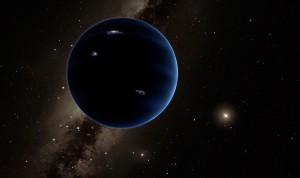Planet Nine From Outer Space
Friday, January 22nd, 2016
This artist’s rendering shows a view of Planet Nine from a perspective facing towards the distant sun. The planet is thought to be gaseous, similar to Uranus and Neptune. Credit: Caltech/R. Hurt (IPAC)
January 22, 2016
On Wednesday, January 20, astronomers Konstantin Batygin and Mike Brown from the California Institute of Technology (Caltech) in Pasadena released a study in The Astronomical Journal suggesting that there may be a ninth planet in the solar system after all. But it isn’t the dwarf planet Pluto, or Eris—or any other tiny, frozen ball of rock, for that matter.
Batygin and Brown analyzed the orbits of six objects with elongated orbits in the Kuiper belt. They noticed that all of these objects orbited the sun in a distinctive way, with their perihelia (the part of an orbit closest to the sun) clustered on one side of the solar system. Using computer simulations, the astronomers suggest that a ninth planet with about 10 times the mass of Earth is causing the orbits of the Kuiper belt objects to cluster in this way.
Predicting the existence of large objects on the edge of our solar system is not a new venture. After Uranus was discovered in 1781, astronomers noted that it was not orbiting exactly as it should, a hint that another large planet was altering its orbit. In 1846, French mathematician Urbain J. J. Le Verrier calculated the orbit of this outer planet and predicted its location in the night sky. Astronomers found the planet—now called Neptune—almost exactly where Le Verrier predicted.
Neptune’s discovery is the only successful prediction of this type to date. Around 1900, American businessman and amateur astronomer Percival Lowell became convinced that a ninth planet lurked beyond Neptune, based on more apparent inconsistencies in Uranus’s orbit. Clyde Tombaugh eventually discovered Pluto using the giant observatory in Flagstaff, Arizona, which Lowell built to look for Planet X. Pluto, however, was far too small to affect the orbit of Uranus. Much later, observations by space probes refined the values for Uranus’s size and mass. These values showed there was no problem with the planet’s orbit after all.
Although the evidence is strong, scientists will have to see Planet Nine to believe it. The planet will be extremely difficult to locate by telescope, despite its apparently large size. It is incredibly far away, from 600 to 1,200 times farther than is the sun from the Earth. Planet Nine completes an orbit every 15,000 years. For comparison, Pluto, the former ninth planet, is only about 40 times farther from the sun than Earth is and it completes an orbit every 248 years. It might take as long as five years of scientists combing the night sky with powerful telescopes to find Planet Nine. Until then, the solar system will have eight planets.


